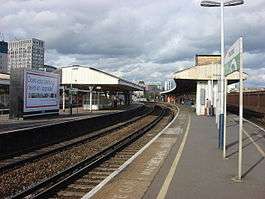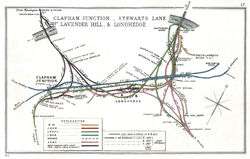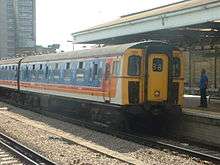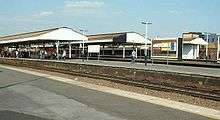Vauxhall station
Vauxhall (/ˈvɒksɔːl/, VOK-sawl) is a National Rail, London Underground and London Buses interchange station in central London. It is at the Vauxhall Cross road junction opposite the southern approach to Vauxhall Bridge over the River Thames in the district of Vauxhall. The mainline station is run by the South Western Railway and is the first stop on the South Western main line from London Waterloo towards Clapham Junction and the south-west. The Underground station is on the Victoria line and the station is close to St George Wharf Pier for river services.
| Vauxhall | |
|---|---|
 | |
 Vauxhall Location of Vauxhall in Greater London | |
| Location | Vauxhall |
| Local authority | London Borough of Lambeth |
| Managed by | South Western Railway |
| Station code | VXH |
| DfT category | B |
| Number of platforms | 10 |
| Accessible | Yes[1] |
| Fare zone | 1 and 2 |
| London Underground annual entry and exit | |
| 2014 | |
| 2015 | |
| 2016 | |
| 2017 | |
| 2018 | |
| National Rail annual entry and exit | |
| 2014–15 | |
| 2015–16 | |
| 2016–17 | |
| 2017–18 | |
| 2018–19 | |
| Key dates | |
| 11 July 1848 | Opened (LSWR) |
| 23 July 1971 | Opened (London Underground) |
| Other information | |
| External links | |
| WGS84 | 51.4854°N 0.1229°W |
The station was opened by the London and South Western Railway in 1848 as "Vauxhall Bridge Station". It was rebuilt in 1856 after a large fire, and given its current name in 1862. In the early 20th century, Vauxhall saw significant use as a stop for trains delivering milk from across the country into London. The tube station opened in 1971 as part of the Victoria line extension towards Brixton, while the bus station opened in 2004. It remains an important local interchange on the London transport network.
Location
The station sits just to the east of Vauxhall Bridge, on a viaduct with eight platforms, straddling South Lambeth Road and South Lambeth Place, alongside Vauxhall Cross.[5][6] On the National Rail network it is the next station on the South Western main line along from London Waterloo, 1 mile 29 chains (2.2 km) to the south-west. On the Underground it is on the Victoria line between Pimlico to the north and Stockwell to the south.[7] The area has several surrounding railways, including the line from Victoria to Streatham.[8] The station is on the boundary of zones 1 and 2 of the London Travelcard area and, although a through station, it is classed as a central London terminus for ticketing purposes.[1][9]
Vauxhall bus station is at ground level, across the road from the railway station. It has a photovoltaic roof supplying much of its electricity, and caters for around 2,000 buses per day.[10]
History
Mainline station

The station is incorporated within the Nine Elms to Waterloo Viaduct. It was opened by the London and South Western Railway (LSWR) as "Vauxhall Bridge Station" on 11 July 1848 when the main line was extended from Nine Elms to Waterloo, then known as "Waterloo Bridge Station". The viaduct was constructed to minimize property disturbances; nevertheless some 700 properties were demolished extending the line past Nine Elms and through Vauxhall.[11]
In the period when Vauxhall was opened, there was no way for an inspector to move through the length of a train to check tickets, so it was used as a ticket stop, like several other stations. Having arrived at Vauxhall, the train would stop for as long as necessary while all tickets could be examined and collected.[12][13]
On 13 April 1856, the station caught fire and was almost totally destroyed. The line was quickly repaired and services through to Waterloo resumed without much delay.[14] After being rebuilt, the station was renamed "Vauxhall" in 1862.[15][lower-alpha 1] In the same year, the LSWR widened the main line through the station.[17] Vauxhall was remodelled in 1936, which included an overhaul of the signalling system up to Waterloo.[18]
Milk trains
In 1921, United Dairies opened a major creamery and milk bottling plant opposite Vauxhall station.[19] Subsequently, milk trains regularly stopped at the station.[8][20] The regular daily milk train was from Torrington, but services from all over the West Country would stop at Clapham Junction in the evening,[21] and reduce their length by half so that they did not block Vauxhall station while unloading. They would then proceed to Vauxhall, and pull into the Up Windsor Local platform, where a discharge pipe was provided to the creamery on the other side of the road.[20][22] There was also pedestrian access from below the station, under the road to the depot, in the tunnel where the pipeline ran. Unloaded trains would then proceed to Waterloo, where they would reverse and return to Clapham Junction to pick up the other half of the train. The procedure was then repeated, so that the entire milk train was unloaded between the end of evening peak traffic and the start of the following morning.[22]
Modern developments
In 2017, work began to modernise the station layout and reduce congestion as part of an £800 million works programme to improve access to Waterloo. The existing lift was replaced and a new staircase was added between platforms 7 and 8 and the concourse.[23]
London Underground

The first proposed underground station at Vauxhall was as part of the West and South London Junction Railway. The line was intended to connect Paddington to Oval via Vauxhall, crossing the River Thames slightly downstream of Vauxhall Bridge. It was rejected in January 1901 for failing to comply with Standing Orders and giving correct notice of eviction, and the plans were quietly shelved.[24] Another abandoned scheme to connect Cannon Street with Wimbledon would have seen an interchange at Vauxhall; these plans were scrapped in 1902 owing to lack of funds.[25]
The current deep tube London Underground station is on the Victoria line, which was the first major post-war underground project in Central London. The line was given approval to be extended from Victoria underneath the Thames to Vauxhall (and onwards to Brixton) in March 1966. To construct the escalator shaft, the ground beneath it was frozen with brine.[26] The station platforms were designed by Design Research Unit and decorated with a motif from the 19th-century Vauxhall Gardens.[27][28] At the same time, Vauxhall Cross road junction was rebuilt in order to accommodate the new Underground station.[29] It was opened on 23 July 1971 by Princess Alexandra.[15][27]
In October 1982, the first automated ticketing system on the Underground was installed at Vauxhall on an experimental basis. The two machines were a "Tenfare" which sold the ten most popular single tickets, and "Allfare" which supplied single and return tickets to any tube station. The experiment ran until July 1983, and was subsequently used in the design of the rollout of the Underground ticketing system across the network.[30]
Bus
The bus station opened in 2004. It was designed by Arup Associates and features a distinctive metallic design constructed out of stainless steel.[31] The station has been criticised for its proximity to the heavy traffic around Vauxhall Cross. In 2011, Transport for London announced they would demolish the bus station and construct a "linear walkway" instead. This was scrapped, but in 2017, they revived the demolition plans as part of general improvements in the area following support from Lambeth Council. The rebuilding is expected to take place between 2019 and 2021.[32] Kate Hoey, member of parliament for Vauxhall has criticised the proposals, calling them a "stitch up".[33]
Services
National Rail

Vauxhall rail station is served by the South Western Railway to and from London Waterloo. Approximately 460 trains travel between the stations each day.[34] The typical off-peak service from Waterloo consists of:[35]
- 2 to Chessington South
- 2 to Dorking
- 2 to Guildford via Cobham
- 2 to Guildford via Epsom
- 2 to Hampton Court
- 2 on the Hounslow Loop Line via Hounslow and Richmond, returning to Waterloo (anti-clockwise)
- 2 on the Hounslow Loop via Richmond and Hounslow, returning to Waterloo (clockwise)
- 2 on the Kingston Loop Line via Kingston and Richmond, returning to Waterloo (clockwise)
- 2 on the Kingston Loop via Richmond and Kingston, returning to Waterloo (anti-clockwise)
- 2 to Shepperton
- 2 to Weybridge via Hounslow
- 2 to Windsor & Eton Riverside
- 2 to Woking
London Underground
Vauxhall is between Pimlico and Stockwell on the Victoria line with a peak time service frequency of 36 trains per hour, or around one every 100 seconds.[36]
Connections
London Buses routes 2, 36, 77, 87, 88, 156, 185, 196, 344, 360, 436 and 452 serve the station.[37]
London River Services are available from nearby St George Wharf Pier.[38] The service was opened in September 2011 by the Mayor of London, Boris Johnson, with the aim of expanding boat transport along the Thames by 20%. A service runs approximately every 40 minutes to the City of London and Canary Wharf.[39]
| Preceding station | Following station | |||
|---|---|---|---|---|
towards Brixton | Victoria line | towards Walthamstow Central |
||
| London Waterloo | South Western Railway South Western Main Line |
Clapham Junction or Queenstown Road (Battersea) | ||
Incidents
- On 11 September 1880, a light engine collided with a service from Waterloo to Hampton. Five passengers were killed.[40]
- On 29 August 1912, a light engine collided with a rake of nine carriages. One passenger was killed and 43 were injured.[41]
- On 20 September 1934, two electric suburban trains collided at Vauxhall. The driver of one train and a passenger were taken to St Thomas' Hospital for treatment.[42]
- On 9 October 2000, an untrained student worker was hit by a train near Vauxhall station while unsupervised. An inquest in May 2002 returned a verdict of unlawful killing.[43]
- On 5 May 2016, a fire broke out in one of the signal cables at Vauxhall station. Services from Waterloo through the station were cancelled and the next major down station, Clapham Junction was closed as an overcrowding measure.[44][45]
Name
The name Vauxhall is phonetically similar to the Russian word for railway station, вокзал (vokzal). One theory for this similarity is that Tsar Nicholas I visited Britain in the mid-19th century to study the railway network. At the time, every train on the South Western Railway called at Vauxhall as a ticket stop. From this, the Tsar concluded that Vauxhall was a major transport interchange, and the word was introduced as the generic term in Russian.[46]
References
Notes
- A station in Birmingham called "Vauxhall" had been opened by the London and North Western Railway on 1 March 1869; it was renamed "Vauxhall and Duddeston" on 1 November 1889 and "Duddeston" on 6 May 1974.[16]
Citations
- Standard Tube Map (PDF) (Map). Not to scale. Transport for London. May 2020. Archived (PDF) from the original on 7 July 2020.
- "Multi-year station entry-and-exit figures (2007-2017)" (XLSX). London Underground station passenger usage data. Transport for London. January 2018. Retrieved 22 July 2018.
- "Station Usage Data" (CSV). Usage Statistics for London Stations, 2018. Transport for London. 21 August 2019. Retrieved 27 April 2020.
- "Station usage estimates". Rail statistics. Office of Rail Regulation. Please note: Some methodology may vary year on year.
- "Vauxhall (Ground Floor)". National Rail Enquiries. Retrieved 12 September 2018.
- "Near Vauxhall Bridge Road". Transport for London. Retrieved 2 December 2018.
- Brown, Joe (19 February 2015). London Railway Atlas. Ian Allan. p. 39. ISBN 978-0-7110-3819-6.
- Davies & Grant 1983, p. 68.
- "'London Terminal' stations". Network Rail. Retrieved 12 September 2017.
- Glancey, Jonathan (11 April 2005). "Architecture – Route master". The Guardian. Retrieved 26 June 2018.
- Jackson 1984, p. 213-215.
- Patmore 1982, p. 171.
- Bradley 2015, p. 52.
- "Destruction Of Vauxhall Railway Station". The Times. London. 14 April 1856. Retrieved 19 September 2018.
- Butt 1995, p. 238.
- Butt 1995, pp. 83,238.
- "Railway Intelligence". The Times. London. 11 April 1862. p. 10. Retrieved 12 September 2018.
- "Southern Railway Improvements". The Times. London. 16 May 1936. p. 8. Retrieved 19 September 2018.
- "United Dairies, Limited". The Times. London. 12 November 1921. p. 17+. Retrieved 12 September 2018.
- Course 1962, p. 92.
- Maidment 2015, p. 15.
- "The Torrington Milk Train". SVS Films. 21 January 2012.
- "Network Rail invites passengers to learn more about Vauxhall station improvements". Network Rail (Press release). 13 March 2017. Retrieved 12 September 2018.
- Badsey-Ellis 2005, p. 98.
- Badsey-Ellis 2005, p. 135.
- Day & Reed 2010, pp. 163,168.
- Day & Reed 2010, p. 171.
- Lawrence 1994, p. 197.
- "Vauxhall takes on new look". The Times. London. 9 April 1970. p. 5. Retrieved 19 September 2018.
- Day & Reed 2010, p. 184.
- "An Ode To Vauxhall Bus Station". September 2016. Retrieved 12 September 2018.
- "End looms for Arup Associates' long-threatened Vauxhall bus station". Architects Journal. 26 September 2017. Retrieved 7 December 2018.
- "Outcry after Lambeth votes to demolish Arup Associates' 'iconic' Vauxhall bus station". Architects Journal. 21 December 2017. Retrieved 8 December 2018.
- "Vauxhall to London Waterloo". The Train Line. Retrieved 8 December 2018.
- "Timetables". South Western Railway. Select the appropriate timetable to verify the train frequency. Retrieved 8 December 2018.
- "Victoria line trains now run every 100 seconds making it the second most frequent line in the world". London Evening Standard. 22 May 2017. Retrieved 19 September 2018.
- "Buses from Vauxhall" (PDF). Transport for London. 19 November 2016. Archived from the original (PDF) on 9 December 2018. Retrieved 9 December 2018.
- "MBNA Thames Clippers Timetable" (Timetable). 21 May 2018. Retrieved 14 September 2018.
- "New floating Thames pier opens at Vauxhall". BBC News. 15 September 2011. Retrieved 2 December 2018.
- "The Vauxhall Railway Accident". The Times. London. 28 September 1880. p. 4. Retrieved 12 September 2018.
- Brodrick, Nick. "LSWR "lavatory brake third"". Steam Railway. Bauer Media (375, 30 April – 27 May 2010): 56.
- "Electric Trains In Collision". The Times. London. 21 September 1934. p. 12. Retrieved 19 September 2018.
- "Student rail worker 'unlawfully killed'". BBC News. 20 May 2002. Retrieved 12 September 2018.
- "Vauxhall Station fire: Ongoing disruption follows blaze". BBC News. 5 May 2016. Retrieved 12 September 2018.
- "Vauxhall station fire disrupts London rail services". 5 May 2016. Retrieved 12 September 2018.
- Reeves, Phil (21 September 1997). "From Vauxhall to Vokzal". The Independent. Retrieved 12 September 2018.
Sources
- Butt, R. V. J. (1995). The Directory of Railway Stations: details every public and private passenger station, halt, platform and stopping place, past and present (1st ed.). Sparkford: Patrick Stephens Ltd. ISBN 978-1-85260-508-7. OCLC 60251199.
- Badsey-Ellis, Antony (2005). London's Lost Tube Schemes. Capital Transport. ISBN 185414-293-3.CS1 maint: ref=harv (link)
- Bradley, Simon (2015). The Railways - Nation, Network and People. Profile Books. ISBN 978-1-84668-209-4.CS1 maint: ref=harv (link)
- Course, Edwin (1962). London railways. B. T. Batsford.CS1 maint: ref=harv (link)
- Davies, R; Grant, M.D. (1983). London and its railways. David & Charles. ISBN 0-7153-8107-5.CS1 maint: ref=harv (link)
- Day, John R; Reed, John (2010) [1963]. The Story of London's Underground. Capital Transport. ISBN 978-1-85414-341-9.CS1 maint: ref=harv (link)
- Jackson, Alan (1984) [1969]. London's Termini (New Revised ed.). London: David & Charles. ISBN 0-330-02747-6.CS1 maint: ref=harv (link)
- Lawrence, David (1994). Underground Architecture. Capital Transport. ISBN 978-1-854-14160-6.CS1 maint: ref=harv (link)
- Maidment, David (2015). A Privileged Journey: From Enthusiast to Professional Railwayman. Pen and Sword. ISBN 978-1-473-85949-4.CS1 maint: ref=harv (link)
- Patmore, John Allan (1982). A Regional History of the Railways of Great Britain: Southern England. David & Charles. ISBN 978-0-715-38365-0.CS1 maint: ref=harv (link)
External links
| Wikimedia Commons has media related to Vauxhall station. |
- Train times and station information for Vauxhall station from National Rail